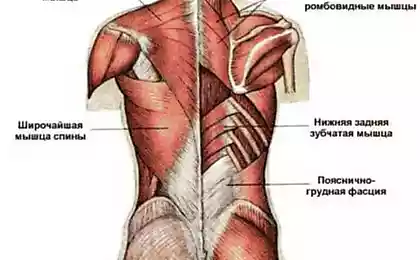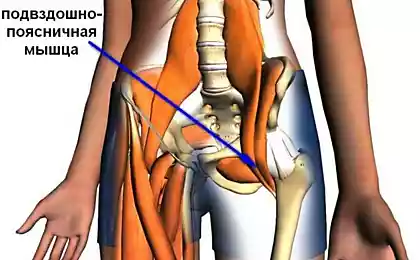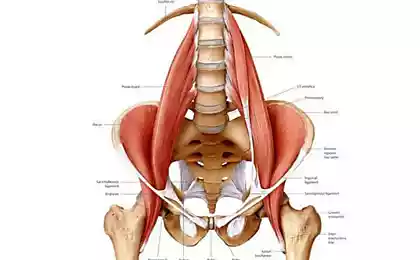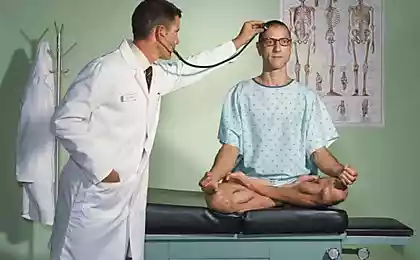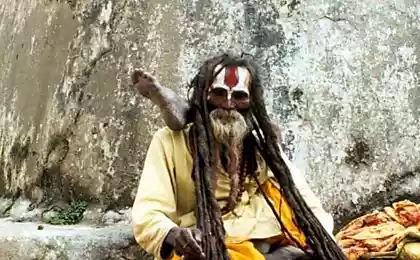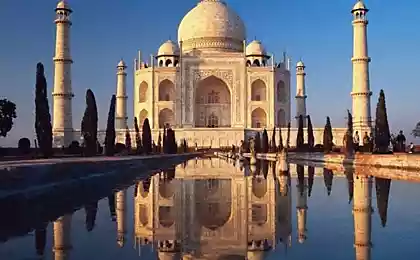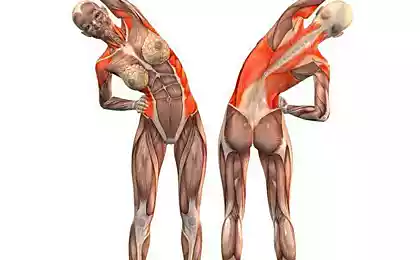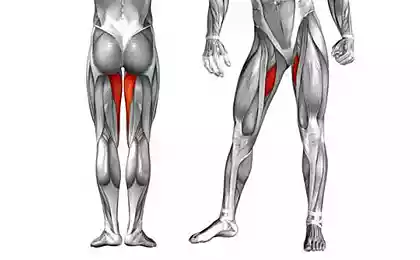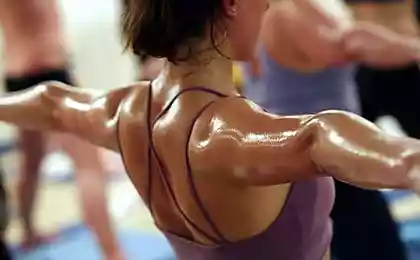551
Psoas muscle – the muscle of the soul
Fifty four million six hundred nine thousand seven hundred seven
“I was very pleased to discover the wonderful work of Liz Koch — after all, she confirmed a lot of what I already knew intuitively.
At the beginning and at the end of yoga I started to do poses that reveal thighs, paying special attention to releasing stress in the psoas muscle and the flexors of the hips. At the same time breathing I tried to imagine the tension stems from tight muscles and is released as energy in the body.It worked. I felt that my body became softer, yet somehow stronger. ( Close ) Reading Liz Koch I instantly realized what I was doing — learning to relax my psoas muscle, I literally fed on its center, restoring its relationship with the powerful energy of the earth. According to Koch, the psoas is much more than just muscle, a stabilizing center. It is a sensory organ consisting of a biologically intelligent tissue and "literally embodies our strongest desire for survival and, on a deeper level, our primal thirst for prosperity and bloom."
Well then, I ought to know more. Here are just a few nuggets from the research of Liz Koch on how much psoas muscle is important for our health, maintain vitality and emotional well-being.
Right and left psoas muscles (psoas)Psoas muscle (psoas) is the deepest muscle of the human body affecting our structural balance, muscular integrity, flexibility, strength, range of motion, joint mobility and organ function.
The lumbar muscles on both sides extends from the spine, being attached to the 12th thoracic vertebra (T12) to each of the five lumbar vertebrae. From here they pass down through the abdomen and pelvis, and then attached to the top of the femur. The Psoas is the only muscle connecting the spine with the legs. She is responsible for the maintenance of the vertical position and is involved in lifting the foot when walking. Properly functioning psoas muscle stabilizes the spine and provides support for the whole body, forming a platform for the vital abdominal organs.
Through connective tissue, or fascia, psoas muscle connects to the diaphragm and resulting impacts on our breath and fear reflex. The fact that the psoas muscle is directly linked to the reptilian brain — the most ancient interior part of the brain stem and spinal cord. Liz Koch writes: "Long before it appeared or developed organizational skills of the cerebral cortex, our existence at the deepest level supported by the reptilian brain, known for its survival instincts".
Liz Koch believes that our modern accelerated way of life, fueled by the adrenaline of the sympathetic nervous system, causes chronic strain of lumbar muscle causing her to be in constant readiness for fight or flight. The Psoas helps you to instantly proceed with the action or to curl up into a protective ball.
If we keep on reducing lumbar muscle due to stress or tension, she begins to shorten which creates prerequisites for painful conditions — back pain, Sacro-iliac, sciatica, problems with vertebrate discs, spondylosis, scoliosis, degeneration of the hip joints, pain in the knees, painful menstruation, infertility and digestive problems.
Chronically compressed psoas muscle (left) has a negative effect on posture, breathing depth and internal organs. Chronically compressed lumbar muscle not only creates structural problems, but also leads to compression of internal organs, puts pressure on nerve fibers, impedes the movement of liquids and prevents the diaphragm breath. In fact, "the psoas muscle is so deeply involved in major physical and emotional reaction that being chronically tense, she constantly feeds your body the signals that you are in danger of depleting the adrenal glands and overloading the immune system".
And, according to Liz Koch, this situation is compounded by the many features of our modern lifestyle — car seats, tight fitting clothes, chairs and shoes, in violation of posture, reducing the range of natural movements and further compressing the lumbar muscle.
Koch believes the first step to recovery psoas is to release unnecessary tension. However "work with the psoas muscle lies not in trying to control it, and in cultivating the awareness needed to feel her message. This means that you consciously make the decision to become somatic receptive".
Relaxed psoas muscle — a prerequisite for playfulness and creative expression. If the compressed lumbar muscle is in constant readiness to flee or fight, being relaxed and released, this muscle always ready to lengthen, open up and dance. In many yoga poses (for example, in vriksasana) the thighs can't fully turn out until you relax psoas. Relaxed psoas muscle contributes to lengthening the front of the hips that allows the legs to move independently from the pelvis and improves the condition of the whole body and heart.
Liz Koch said that doing a recovery of the psoas, we can rekindle our vitality, learning to connect with the life force of the universe. In the Taoist tradition, lumbar muscle called the throne or the muscle of the soul as it surrounds the lower dantian is the main energy center of the body. Flexible and strong psoas muscle grounds us and enables subtle energies to flow through our bones, muscles and joints.
Liz Koch writes: "Being a conductor of energy, the psoas connects us with the earth, like the ground wire protects against shocks and eliminates static in the radio. Freed and grounded the spine can awaken" ... "as soon as the flow of gravity through the bones, tissues and muscles transfers body weight to the ground, earth has the opposite effect, lifting through the legs and spine, enlivening and coordinate posture, movement and expression. It is an ongoing conversation between the human self, earth and cosmos."
And next time, when you do your practices, you may find it useful to attune with this biologically reasonable muscle and pay attention to what she wants to tell you”.
Author: Daniel Proch Olson
Source: www.all-yoga.ru/blogs/archives/775#more-775
“I was very pleased to discover the wonderful work of Liz Koch — after all, she confirmed a lot of what I already knew intuitively.
At the beginning and at the end of yoga I started to do poses that reveal thighs, paying special attention to releasing stress in the psoas muscle and the flexors of the hips. At the same time breathing I tried to imagine the tension stems from tight muscles and is released as energy in the body.It worked. I felt that my body became softer, yet somehow stronger. ( Close ) Reading Liz Koch I instantly realized what I was doing — learning to relax my psoas muscle, I literally fed on its center, restoring its relationship with the powerful energy of the earth. According to Koch, the psoas is much more than just muscle, a stabilizing center. It is a sensory organ consisting of a biologically intelligent tissue and "literally embodies our strongest desire for survival and, on a deeper level, our primal thirst for prosperity and bloom."
Well then, I ought to know more. Here are just a few nuggets from the research of Liz Koch on how much psoas muscle is important for our health, maintain vitality and emotional well-being.
Right and left psoas muscles (psoas)Psoas muscle (psoas) is the deepest muscle of the human body affecting our structural balance, muscular integrity, flexibility, strength, range of motion, joint mobility and organ function.
The lumbar muscles on both sides extends from the spine, being attached to the 12th thoracic vertebra (T12) to each of the five lumbar vertebrae. From here they pass down through the abdomen and pelvis, and then attached to the top of the femur. The Psoas is the only muscle connecting the spine with the legs. She is responsible for the maintenance of the vertical position and is involved in lifting the foot when walking. Properly functioning psoas muscle stabilizes the spine and provides support for the whole body, forming a platform for the vital abdominal organs.
Through connective tissue, or fascia, psoas muscle connects to the diaphragm and resulting impacts on our breath and fear reflex. The fact that the psoas muscle is directly linked to the reptilian brain — the most ancient interior part of the brain stem and spinal cord. Liz Koch writes: "Long before it appeared or developed organizational skills of the cerebral cortex, our existence at the deepest level supported by the reptilian brain, known for its survival instincts".
Liz Koch believes that our modern accelerated way of life, fueled by the adrenaline of the sympathetic nervous system, causes chronic strain of lumbar muscle causing her to be in constant readiness for fight or flight. The Psoas helps you to instantly proceed with the action or to curl up into a protective ball.
If we keep on reducing lumbar muscle due to stress or tension, she begins to shorten which creates prerequisites for painful conditions — back pain, Sacro-iliac, sciatica, problems with vertebrate discs, spondylosis, scoliosis, degeneration of the hip joints, pain in the knees, painful menstruation, infertility and digestive problems.
Chronically compressed psoas muscle (left) has a negative effect on posture, breathing depth and internal organs. Chronically compressed lumbar muscle not only creates structural problems, but also leads to compression of internal organs, puts pressure on nerve fibers, impedes the movement of liquids and prevents the diaphragm breath. In fact, "the psoas muscle is so deeply involved in major physical and emotional reaction that being chronically tense, she constantly feeds your body the signals that you are in danger of depleting the adrenal glands and overloading the immune system".
And, according to Liz Koch, this situation is compounded by the many features of our modern lifestyle — car seats, tight fitting clothes, chairs and shoes, in violation of posture, reducing the range of natural movements and further compressing the lumbar muscle.
Koch believes the first step to recovery psoas is to release unnecessary tension. However "work with the psoas muscle lies not in trying to control it, and in cultivating the awareness needed to feel her message. This means that you consciously make the decision to become somatic receptive".
Relaxed psoas muscle — a prerequisite for playfulness and creative expression. If the compressed lumbar muscle is in constant readiness to flee or fight, being relaxed and released, this muscle always ready to lengthen, open up and dance. In many yoga poses (for example, in vriksasana) the thighs can't fully turn out until you relax psoas. Relaxed psoas muscle contributes to lengthening the front of the hips that allows the legs to move independently from the pelvis and improves the condition of the whole body and heart.
Liz Koch said that doing a recovery of the psoas, we can rekindle our vitality, learning to connect with the life force of the universe. In the Taoist tradition, lumbar muscle called the throne or the muscle of the soul as it surrounds the lower dantian is the main energy center of the body. Flexible and strong psoas muscle grounds us and enables subtle energies to flow through our bones, muscles and joints.
Liz Koch writes: "Being a conductor of energy, the psoas connects us with the earth, like the ground wire protects against shocks and eliminates static in the radio. Freed and grounded the spine can awaken" ... "as soon as the flow of gravity through the bones, tissues and muscles transfers body weight to the ground, earth has the opposite effect, lifting through the legs and spine, enlivening and coordinate posture, movement and expression. It is an ongoing conversation between the human self, earth and cosmos."
And next time, when you do your practices, you may find it useful to attune with this biologically reasonable muscle and pay attention to what she wants to tell you”.
Author: Daniel Proch Olson
Source: www.all-yoga.ru/blogs/archives/775#more-775

